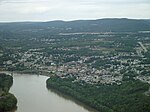Twin Shaft disaster
1896 disasters in the United States1896 in Pennsylvania1896 mining disastersCoal mining disasters in PennsylvaniaDisasters in Pennsylvania ... and 4 more
Engineering failuresHistory of Luzerne County, PennsylvaniaJune 1896 eventsPittston, Pennsylvania

The Twin Shaft disaster occurred in the Newton Coal Company's Twin Shaft Colliery in Pittston, Pennsylvania, United States, on June 28, 1896, when a massive cave-in killed fifty-eight miners.
Excerpt from the Wikipedia article Twin Shaft disaster (License: CC BY-SA 3.0, Authors, Images).Twin Shaft disaster
North Main Street,
Geographical coordinates (GPS) Address Nearby Places Show on map
Geographical coordinates (GPS)
| Latitude | Longitude |
|---|---|
| N 41.341555555556 ° | E -75.785933333333 ° |
Address
North Main Street 681
18640
Pennsylvania, United States
Open on Google Maps








